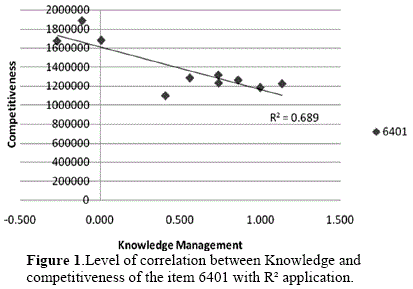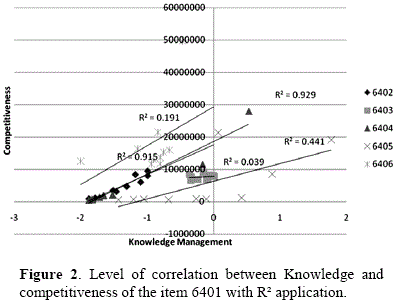Services on Demand
Journal
Article
Indicators
-
 Cited by SciELO
Cited by SciELO -
 Access statistics
Access statistics
Related links
-
 Similars in
SciELO
Similars in
SciELO
Share
Revista Ciencia, Tecnología e Innovación
Print version ISSN 2225-8787
Rev. Cien. Tec. In. vol.11 no.12 Chuquisaca Dec. 2015
ARTICULO
Los flujos de conocimiento de las empresas de exportación de fabricación de calzado en México.
Caso de estudio de su productividad y competitividad
The Knowledge Flows of Footwear Manufacturing Exportation Companies in Mexico.
Study Case of Their Productivity and Competitiveness
CONTRERAS - David1*, SOCORRO - Elia2, GORDILLO - José1
1 Universidad Tecnológica del Suroeste de Guanajuato, Carr. Valle huanímaro Km 1.2, 38400
Valle de Santiago Guanajuato, México, dicontreras@utsoe.edu.mx
2 Universidad Autónoma de Queretero, Cerro de las Campanas s/n, 76010,
Santiago de Querétero, Querétero, México, eldiaz90@hotmail.com.
Recibido Septiembre 05, 2015; Aceptado Diciembre 07, 2013
Resumen
Este estudio de caso trata de exponer los flujos de conocimiento y su relación con la competitividad de la industria manufacturera de exportación del calzado en México a través del modelo teórico y prueba de hipótesis aplicada (coeficiente de determinación R2 y ![]() chi cuadrado). La investigación se llevó a cabo empleando un método cuantitativo basado en 3 etapas: 1) datos de recaudación de exportaciones de 120 meses (2003-2012); 2) la aplicación del modelo y 3) análisis de correlación entre el conocimiento y la competitividad. La investigación demuestra que el flujo de conocimiento en las necesidades mexicanas de exportación de la industria del calzado apoyo porque todavía es, en muchos casos, muy pobre, por otro lado, revela algunas mediciones de conocimiento positivos, simplemente en algunos casos en diferentes años.
chi cuadrado). La investigación se llevó a cabo empleando un método cuantitativo basado en 3 etapas: 1) datos de recaudación de exportaciones de 120 meses (2003-2012); 2) la aplicación del modelo y 3) análisis de correlación entre el conocimiento y la competitividad. La investigación demuestra que el flujo de conocimiento en las necesidades mexicanas de exportación de la industria del calzado apoyo porque todavía es, en muchos casos, muy pobre, por otro lado, revela algunas mediciones de conocimiento positivos, simplemente en algunos casos en diferentes años.
Palabras Clave: Conocimiento. Competitividad. Productividad.
Abstract
This study case tries to expose the Knowledge flows and its relationship with the competitiveness of the footwear manufacturing exportation industry in Mexico trough a theoretical model and applied hypothesis test (determination coefficient R2 and chi square ![]() ). The research was conducted employing a quantitative method based in 3 stages: 1) Collection data from exportations of 120 months (2003-2012); 2) Model application, and 3) analysis of correlation between knowledge and competitiveness. The research corroborates that the knowledge flow in the Mexican footwear industry exportation needs support because still is, in many cases, very poor, on the other, reveals some hard positive knowledge measurements, just in some cases through different years.
). The research was conducted employing a quantitative method based in 3 stages: 1) Collection data from exportations of 120 months (2003-2012); 2) Model application, and 3) analysis of correlation between knowledge and competitiveness. The research corroborates that the knowledge flow in the Mexican footwear industry exportation needs support because still is, in many cases, very poor, on the other, reveals some hard positive knowledge measurements, just in some cases through different years.
Keywords: Knowledge. Competitiveness. Productivity.
Introducction
To an important number of organizations, the creating, managing and transferring knowledge is at the top of agenda. Futurist, economist and academics have recognized for many years that the world is moving towards a global 'Knowledge economy' (Chase, 1997).
The knowledge, it can find in all kind of organizations. The different forms of management, including measurement, creating or transferring it are being utilized by organizations toward getting competitive advantages. Since Knowledge Management KM represents one of the most critical variables to get an organizational success (Argyris and Schon, 1978; Nonaka, 1991; Kogut and Zander, 1992), an increasing number of companies have launched KM initiatives (Mu-Yen and An-Pin, 2006).
Organizations like Hughes Space & Communications Co. and Ford Motor Company utilized the KM to minimize the costs and production cycle keeping on an innovative ability (Ward and Leo 1996). Research of Business Intelligence, Ernst & Young Center for Business Innovation of 431 U.S. and European organizations reported that 87% of people describe their corporations as knowledge-intensive, indicating that knowledge and its manipulation is critical to their competitiveness (Holsapple and Singh, 2001).
Additionally, a survey conducted by Journal of Knowledge Management with the assistance of Best Practice Club and the Benchmarking Exchange in 1997 reveals that over 90% of respondents perceive their organizations being knowledge-intensive but only a 6% were characterized as very effective to achieve better performance (Chase, 1997).
The KM is becoming a relevant practice inside the organizations not only for their success, but also for the development of societies (Ragab and Arisha, 2013). In this sense the benefit most expected from KM has been improve decision making with 89% (Chase, 1997).
In this sense, their measure is until recent years, conformed as the basis of continual improvements for organizational performance and one of the most difficult activities (Chen et al., 2009). Metrics definition inside organizations is, at the same time, one of the most important principles (Besic and Djordjevic, 2007), and its importance is very significant (Velimirović et al., 2011); an example of this, is the relevance of KM evaluation to managers from Asia, United States and United Kingdom (Mu-Yen and An-Pin, 2006). For this reason, several models have been created and used for measure, create, manage or transfer knowledge at different levels, considering many factors with the sole purpose to obtaining organizational performance.
One of the proposed models focused on trait is Trumbo's (1961); the spiral knowledge model, from Nonaka and Takeuchi (1991) is focused on the conversion of tacit knowledge to explicit knowledge for properly exposing inside the company. This model has been precursor from many concepts and further research (Lloria, 2000). Another way of achieving this was developed by a prominent international panel of practitioners and academics of KM known as the Knowledge Chain model (Holsapple and Singh, 2001). This model helps to measure the learning level of organizations considering the creation of new knowledge, identifying some activities focused on knowledge acquisition, identification, selection, generation, internalization and externalization included in primary activities and measure, control, coordination and leadership corresponding to secondary activities.
Besides, we have the Manufacturing Small and Medium Enterprises SMEs Knowledge Management model from Alfaro (2008). This model exposes the relationship between culture, direction style, structural and relational capital trying to achieve a systemic approach and knowledge.
By the application of the previous models at different level, a visible increment on the competitively index can be obtained; however, the high overall inherent costs involving resources such as time application, have derived on a low success of this scheme.
Other model is the Return Of Investment (ROI) that was utilized by Laitamaki and Kordupleski (1997) to evaluate the KM projects and performance of Customer Value Added CVA; the knowledge-based-system model from Stein et al., (2001) was designed to automate task and capture knowledge; however, according with Holt et al., (2007) the models that assess KM were focused for the individual attributes; the organizational culture and climate and the specific change or the process.
For these reasons, measure, create, manage or transfer knowledge is at the top of organizational agenda. Most of KM models are focus on measure and evaluation Knowledge trough different paradigms. So, to get a SMEs measure knowledge is advisable utilize a simple method and less demanding in time and financial resources (Kozena and Chládek, 2012).
In spite of the creation of the latest models, actually the evidence indicates that KM still intimidates to managers and their companies (O'Dell and Hubert, 2011). So, how do most firms that have initiated a new way to measure, create, manage or transfer knowledge develop appropriate metrics to gauge the effectiveness of their initiative?
There is a need for a model to measure Knowledge initiatives from the companies (Mu-Yen and An-Pin, 2006) and be comprehensive yet straightforward enough to be understood by all those who will apply them (Ragab and Arisha, 2013) and improve their decision making and get their competiveness.
In many studies, the correlation of Knowledge with another paradigms is positive, like marketing of Griffin and Hauser (1996); the research of Henard and Szymanksi (2001) with new product performance or the relation with organizational climate like antecedent of KM from Jaworski and Kohli (1993), or the research from Darroch (2005) applied in New Zealand organizations with 50 or more employees. In this study the KM is how it through three components (knowledge acquisition, dissemination and responsiveness) and all of them have a direct effect on innovation, just there are very few studies between Knowledge and competiveness like the research from Liu, Chen and Tsai (2004) considering four main functions, knowledge obtaining, knowledge refining, knowledge storing and knowledge sharing over Taiwan's industries.
The result reveals that Knowledge capability has a tremendous effect on competitiveness. In the same sense, Liu, Chen and Tsai (2005) exhibit the positive effect between the KM and a new product development strategy in high-tech industries. The results indicate that KM practices are positively associated with organizational performance in qualitative and quantitative method (Davenport and Prusak, 1998; Massey et al., 2002; Nonaka, 1994; Choi and Lee, 2003; Darroch and McNaughton, 2003; Lee and Choi, 2003; Schulz and Jobe, 2001; Simonin, 1997; Tanriverdi, 2005) but most of them are descriptive (Chauvel and Dupres, 2002).
There exists another model called Comparative Advantage Revealed Index CARI model development by United Nations for the Industrial Development Organizations UNIDO in 1985. The CARI model considers exportati ons level against importations encompassing the heterogeneity of all product prices from supply chain resulting in a positive (comparative advantage) or negative (comparative disadvantage) according the mathematical equation. In this sense, the purpose is measure the Knowledge level of footwear industry exporting in Mexico through CARI model application trying to encompass others factors that could influence in the organizational competitiveness and purpose another form to evaluate the Knowledge showing comparative advantage or disadvantage of footwear industry from Mexico.
In Mexico, there are companies that contribute in an important way to the economic development of the country (organizations and society) that's the case of the footwear industry.
The footwear industry in Mexico during four decades were considered one of the most important industries in Mexico, producing 217 million of footwear shoe pair utilizing 168 thousand workers (Hernández, 2007), having 8008 economic units and increasing its exportations to 3.6 million in the first semester of 2012, which is an upward growth of 21.8% in comparison with the same period of last year (Canaical, 2012). This information reflects an increase of the industry boosting interaction between science and technology through knowledge (Imco, 2013). So, the footwear industry continues being, in Mexico, the most important industry in production, exportations and employment (Gracia Hernández, 2009), that is to say getting the right knowledge to the right people at the right time to improve the organizational performance (O'Dell et al., 1998).
The objective for this research was to conduct an exploratory quantitative study to create a broader set of evidence regarding of the Knowledge flow and its relationship with competitiveness of manufacturing industry exporting from Mexico through of straightforward and comprehensive called CARI model that try to support and improve in the future, the decision making of the industry and increase the competitivity.
Research method
Due to, the knowledge's concept is extremely complex and is not easily defined as one concise definition, the first concept was based on Laal's contribution like "know-how" (Laal, 2011). The second concept, competitiveness, was based on the World Economic Forum WEF and defined as a "series of factors, politics and institutions that determinate a productivity level of a country (Sala-I-Martin et al., 2007).
The research design utilized was quantitative, exploratory and not-experimental, with three objectives:
- Evaluate the Knowledgelevel of the footwear industry exporting of Mexico.
- Measure the correlation between Knowledge and their competitiveness level of the footwear industry of Mexico.
- Identify the dependence or independence correlation of Knowledge and competitiveness of the footwear industry exporting of Mexico.
The research was based in six hypotheses:
H0: The Knowledge average flow of the footwear industry exporting in Mexico is negative.
H0-1: The Knowledge and competitiveness correlation of the footwear industry exporting in Mexico are less of 0.5.
H0-2: The Knowledge and competitiveness correlation average is independent.
H1: The Knowledge average flow of the footwear industry exporting in Mexico is positive.
H1-1: The correlation level between Knowledge and competitiveness of the footwear industry exporting in Mexico, is greater than 0.5.
H1-2: The Knowledge and competitiveness correlation average of the footwear industry exporting in Mexico are dependent.
To delimitate the study according with Knowledge's concept, were considered the balance of tradedimension, theexportations and importations and the result of CARI model application in order to express the operativity of KM. To properly measure competitiveness concept, the productiveness dimension was considered troughthe exportations measure by shoe pair.
The analysis of the variables was developed through identification of the Knowledge level and competitiveness as follows: Knowledge as independent variable and competitiveness as dependent.
For this study, an analysis tool of 16 questions considering likert scale, with a reliability of 0.712, measured through the Cronbachcoeffitienta, was applied, based on Nunnally (1978) the reliability level was acceptable if the value was at least 0.7 for the exploratory research.
Besides that, the correlation level was verified through determination coefficient R2 supported with hypothesis test with chi-square application ![]() to probe dependence or independence.
to probe dependence or independence.
The methodological research contains 3 stages. Stage 1 requests the exportation and importation data; stage 2 shows the CARI model application and stage 3 analyzes the correlation between Knowledge and competitiveness according R2 and ![]() .
.
Development
Stage 1: The data of the comparative advantages revealed that index CARI was obtained of exportation and importation levels of the footwear industry in Mexico in different sections. The information, of shoe pair data recollected, was conformed from 2003 to November 2012 according to the chapter number 64 of SIAVI (Internet Tariff Information System): footwear, leggings, booties and articles. A database was built containing the information of the current situation of the footwear industry in Mexico, related with both exportations and importations considering six sub items having 59 fractions.
6401 Waterproof footwear with sole and rubber on top. The top can't get joined to the sole by seam or by rivets, nails, screws, spikes or similar devices, or be formed with different unit parts in the same way.
6402 Footwear with sole and rubber or plastic top.
6403 Footwear with rubber, plastic, natural leather or regenerated sole and natural leather top.
6404 Footwear with rubber, plastic, natural leather or regenerate sole and textile top.
6405 Other footwear styles.
6406 Parts of footwear.
Stage 2: To estimate the CARI model equation it was necessary to conform the whole set of exportations and importations classified by pair shoe. The estimation of the average flux was evaluated and balance trade was obtained. After this, the mathematical model was applied: the result of the commercial balance of the country against the average of the worldwide commercial flux multiplied by the division of the average of the worldwide commercial flux.
CARI model equation
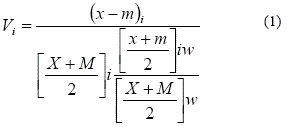
x Exportations per item, sub item and fractions of the footwear sector.
m Importations per item, sub item and fractions of the footwear sector.
X Total exportations of the footwear sector.
M Total importations of the footwear sector.
i Represents a branch of the footwear per item.
j Denotes the country were the research was made.
w Denotes the total of items of the manufacturing sector of footwear.
Stage 3: To prove the correlation between Knowledge and competitiveness the operativity of concepts per item was analyzed. Firstly, the competitiveness trough exportations level was included in the CARI model results. After this, the method of coefficient determination was adopted for measuring both concepts R2.
Supporting this there was applied a chi square ![]() to make sure the dependence or independence between variables.
to make sure the dependence or independence between variables.
Results
The application of CARI model, showed in table 2, revealed, on few years, some positive balances in the Knowledgeflow and, on the other hand, some negative. According the results, all the items have negative score in any given year. The highest measured negative level was -2.000 in 2010, corresponding to the item 6406. On the other hand, the highest positive level was localized in 2005 for item 6405 reaching 1.773, but, in spite of this, the average for the 6402, 6403, 6404, 6405, 6406 items was negative.
In the other hand, based on the CARI model, the Knowledgeflow in the footwear industry exporting in Mexico, from 2003 to 2012, has shown a variable average. Just in 6401 item a positive index was yielded.
Besides, the results of correlation level of Knowledge and competitiveness measure by pair shoe for every year, were over 0.5 in tree items while in others were below.
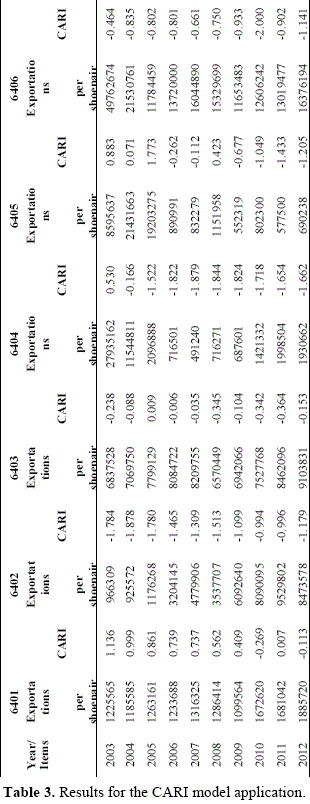
In accordance with the figure 1, the information presented and applying the coefficient for the item 6401, a correlation between competitiveness (production level) and Knowledge (CARI results) of 0.689 were obtained but with an inverse correlation.
This index reveals a specific relation with the level of Knowledge and competitiveness for the items 6402, 6403, 6404, 6405, and 6406. It was obtained two items having a very high correlation (higher than 0.9), three of them with a very low value (less than 0.5). For the 6402 and 6404 correlation levels were of 0.915 and 0.9299 but the 6403, 6505 and 6406 were obtained 0.0391, 0.4419 and 0.1913 respectably. The interpretation of this is that the corresponding Knowledge level doesn't necessarily means a higher level of competitiveness for some items while in others it's extremely important (see Figure 2).
According to the graphics for 6401 the KM doesn't reflect the highest competitiveness level, but CARI result average is positive; to 6402, 6404 and 6406 items the Knowledge increase reflects a high competitiveness level of the industry.
For 6403 item, even though the Knowledge level doesn't show an increase of competitiveness so there's no relation; and to 6405 it could perceive a medium relation.
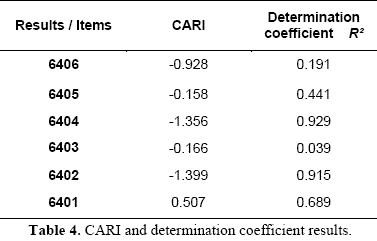
The correlation level between Knowledge and competitiveness for all items was supporting with chi square application. The average of R2supporting with ![]() considering 9 liberty grades and 0.10 of significance were 0.5344 and 17.289. In this sense, it could support the correlation of Knowledge and competitiveness in footwear manufacturing industry exporting from Mexico.
considering 9 liberty grades and 0.10 of significance were 0.5344 and 17.289. In this sense, it could support the correlation of Knowledge and competitiveness in footwear manufacturing industry exporting from Mexico.

Keeping in mind all the items, the results show an average above 0.5, so the variation of the independent variable Knowledge explains the 53.44% of the variation in the dependent variable in the footwear industry (competitiveness).
Conclusions
- From the results obtained in the present research, the Knowledge flow it looks like, for the most of items, and ecrease. It is concluded that in a global level the footwear industry exporting in Mexico hasn't registered an optimum Knowledgeflow because its average was registered in -0.5838, so the H0 is accepted and H1 is rejected.
- According with the correlation level between the Knowledge and the competitiveness of the footwear industry exporting in Mexico is higher or less to 0.5 in a general level, and according to R2, registering an average value of 0.5344 so H1-lis accepted and H0-lis rejected.
- To probe the dependence or independence was obtained chi square result of 17.289so the H1-2 is accepted; and H0-2 is rejected. With this result it can be concluded that there is a general relation between Knowledge and competitiveness in the manufacturing industry of footwear exporting in Mexico. Finally, the construct validity between theory, hypothesis and results was approved through the overall results obtained.
- Since it presented an average value of 0.507 during the analyzed years of 6401 item so, this measurement can be considered as an indicator of an optimum Knowledge level. The correlation between Knowledge and competitiveness was of 0.6893, but, since the latter value represents an inverse relationship, it is advisable to consider another's elements in order to leverage this result.
- The above reflects the Knowledge flow in the manufacturing industry of footwear in Mexico, full of ups and downs.
- It is not enough with market aperture, an inside overlook to the manufacturing footwear is needed, and, on this basis, decide on another kind of strategy, like Zundel (2012) quotes: "our ability for reflection has to be understood from inside our enmeshing with space and time".
- The footwear industry production in Mexico is growing up, this could reflect a positive perception by the entrepreneurs, their costumers and government but, once the CARI model was applied, the industry reflects opposite results: in accordance with H1, where it is assumed that the average Knowledge of the footwear industry in Mexico is positive. A future study will be aimed at other types of industries. By consulting this research, all industries exporting can adapt themselves to determine their Knowledge and its management and could measure their competitiveness.
Acknowledgments
This research was supported by Technological University of the Southwest of Guanajuato trough business development department and Autonomous University of Queretaro by Administration Doctorate Program.
Notas
Citación: Contreras D, Socorro E, Gordillo J. The knowledge flows of footwear manufacturing exportation companies in Mexico. Study case of their productivity and competitiveness. Revista Ciencia, Tecnología e Innovación 2015, 11-12: 697-708
References
- Alfaro CGG (2008) Modelo de gestión del conocimiento para las pymes manufactureras Cienciasempresariales19, 38-47. [ Links ]
- Argyris C and Schön D (1978) Organizational Learning: A theory of action perspective. Addison-Wesley Pub. Co, Universidad of Michigan. [ Links ]
- Besic C and Djordjevic D (2007) Benchmarking. Cacak, Faculty of Engineering. [ Links ]
- Chen M, Huang M and Cheng Y (2009) 'Measuring knowledge management performance using acompetitive perspective: an empirical study Expert Systems with Applications 36(4), 8449-8459. [ Links ]
- Chase RL (1997) The knowledge-based organization: an international survey Journal of Knowledge Management 1(1), 38-49. [ Links ]
- Chauvel D and Dupres C (2002) A review of survey research in knowledge management: 1997: 2001 Journal of Knowledge Management 6(3), 207-223. [ Links ]
- Choi B and Lee B (2003) An emprirical investigation of KM styles and their effect on corporate performance Information and Management 40(5), 403-417. [ Links ]
- Darroch J and McNaughton R (2003) Beyond market orientation: Knowledge management and the innovativeness of New Zealand firms European Journal of Marketing 37(3, 4), 572-593. [ Links ]
- Darroch J (2005) Knowledge management, innovation and firm performance Journal of Knowledge Management 9(3), 101-115. [ Links ]
- Davenport T and Prusak L (1998) Working Knowledge: How Organizations Manage What They Know. Harvard Bussiness School Press, Boston. [ Links ]
- Gracia Hernández M (2009) An analysis of the footwear industry in León Guanajuato-México, based on external economies and urbanization Economía autónoma 3, 1-28. [ Links ]
- Griffin A and Hauser JR (1996) Integrating R&D and marketing: a review and analysis of the literature Journal of Product and Innovation Management 13(3), 191-215. [ Links ]
- Henard DH and Szymanksi DM (2001) Why some new products are more successful than others Journal of Marketing Research 38(3), 362-375. [ Links ]
- Hernández OC (2007) Análisis administrativo.Técnicas y métodos. Universidad estatal a distancia, San José Costa Rica. [ Links ]
- Herscovitch L and Meyer JP (2002) Commitmetto organizational change: extension of a three-component model Journal of Applied Psychology 87(3), 474-487. [ Links ]
- Holsapple C (2003) Handbook on Knowledge Management 2: Knowledge Directions. Springer-Verlag Berlin - Heidelberg, Germany. [ Links ]
- Holsapple CW and Singh M (2001) The knowledge chain model: activities for competitiveness Expert Systems with Applications 20(1), 77-98. [ Links ]
- Holt DT, Bartczak SE, Clark SW and Trent MR (2007) The development of an instrument to measure rediness for Knowledge management Knowledge management research & practice 5(2),75 - 92. [ Links ]
- Jaworski BJ and Kohli AK (1993) Market-orientation: antecedents and consequences Journal of Marketing 57(3), 53-70. [ Links ]
- Kogut B and Zander U (1992) Knowledge of the Firm, Combinative Capabilities, and the Replication of technology Organization Science 3(3), 383-397. [ Links ]
- Kozená M andChládek T (2012) Company competitiveness measurement depending on its size and field of activities Procedia - Social Behavioral Sciencies 58(2012), 1085 - 1090. [ Links ]
- Laal M (2011) Knowledge management in higher education Procedia computer Science 3(2011), 544-549. [ Links ]
- Laitamaki J and Kordupleski R (1997) Building and deploying profitable growth strategies based on the waterfall of customer value added European Management Journal 15(2), 158-66. [ Links ]
- Lee H and Choi B (2003) Knowledge management enablers, processes and organizational performance: an integrative view and empirical examination Journal of Management Information Systems 20(1), 179-228. [ Links ]
- Levin RI and Rubín DS (2010) Estadística para administración y economía. Seventhed, Pearson, México. [ Links ]
- Liu PL, Chen WC and Tsai CH (2004) An empirical study on the correlation between knowledge management capability and competitiveness in taiwan's industries Technovation 24(2004), 971-977. [ Links ]
- Liu PL, Chen WC and Tsai CH (2005) An empirical study on the correlation between the knowledge management method and new product development strategy on product performance in Taiwan's industries Technovation 25(2005), 637-644. [ Links ]
- Lloria MB (2000) Una revisión crítica a los principales modelos de gestión del conocimiento.Paper presented at the X congreso ACEDE. Oviedo. [ Links ]
- Mexican Institute for the competitiveness IMCO [WWW document] http://www.imco.org.mx (accessed 20 Jul 2013). [ Links ]
- Massey AP, Montoya-Weiss MM and O'Driscoll TM (2002) Knowledge management in pursuit of performance Journal of Knowledge Management 10(3), 143-156. [ Links ]
- Mu-Yen C and An-Pin C (2006) Knowledge management performance evaluation: a decade review from 1995 to 2004 Journal of information science 32(1), 17-38. [ Links ]
- National Industry of Footwear Camera CANAICA [WWW document] http://www.canaical.org (accessed 8 Abril 2013) [ Links ]
- Nonaka I(1991) The knowledge creating Company Harvard business review 69(6), 96-104. [ Links ]
- Nonaka I(1994) A dynamic theory of organizational knowledge creation Organization Science 5(1), 14-37. [ Links ]
- Nunnally JC(1978) Psychometric Theory. Second ed. McGraw-Hill, New York. [ Links ]
- O'Dell C, Grayson C and Essaides N (1998) If Only we Knew What we Know: the Transfer of Internal Knowledge and Best Practice. Simon and Schuster, London. [ Links ]
- O' Dell C and Hubert C (2011) The New Edge in Knowledge.APQC John Wiley & sons, USA. [ Links ]
- Porter M (1990) The competitive advantage of nations Harvard Business review 68(2). [ Links ]
- Ragab MA and Arisha A(2013) Knowledge management and measurement: a critical review Journal of Knowledge Management 17(6), 873-901. [ Links ]
- Sala-I-Martin X, Blanke J, Drzeniek Hanouz M, Geiger T, Mia I and Paua F (2007) The global competitiveness index: measuring the productive potential of nations working paper World economic forum of Switzerland, 3-81. [ Links ]
- Schulz M and Jobe LA (2001) Codification and tacitness as knowledge management strategies: an empirical exploration Journal of High Technology Management Research 12(1), 139-165. [ Links ]
- Simonin BL (1997) The importance of collaborative know-how: an empirical test of the learning organization Academy of Management Journal 40(5), 1150-1174. [ Links ]
- Stein EW, Manco MP and Manco SA (2001) A knowledge based system to assist university administrators in meeting disability act requirements Expert Systems with Applications 21(2), 65-74. [ Links ]
- Tanriverdi H (2005) Information technology relatedness, knowledge management capability and performance of mul ti-business firms MIS Quarterly 29(2), 311-334. [ Links ]
- Tariff Information System Internet Platform SIAVI[WWW document] http://200.77.231.38/ (accessed 15 May 2013) [ Links ]
- Trumbo DA (1961) Individual and group correlates of attitudes toward work-related change Journal of Applied Psychology 45(5), 338-344. [ Links ]
- United Nations Industrial Development Organization (1985) International patterns of comparative advantage. Industry in the 1980. Structural change and interdependence, Nueva York. [ Links ]
- Velimirović D, Velimirović M and Stanković R (2011) Role and importance of key performance indicators measurement Serbian Journal of Management 6(1), 63 - 72. [ Links ]
- Ward A and Leo V (1996) Lessons learned on the knowledge highways and byways Strategy & Leadership 24(2), 16-20. [ Links ]
- Zundel M (2012) Walking to learn: Rethinking reflection for management learning Management Learning 44 (2), 109-126. [ Links ]















